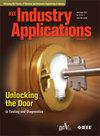Virtual Inertia Control for Damping Low-Frequency Oscillation in IBR-Dominated Networks
IF 4.2
2区 工程技术
Q2 ENGINEERING, ELECTRICAL & ELECTRONIC
引用次数: 0
Abstract
Increased reliance on renewables brings challenges to maintaining the electric networks’ inertia and damping and poses concerns about network stabilization. The virtual synchronous generator (VSG) technique has been adopted for dealing with stability issues in networks with high Inverter-Based Resource (IBR) penetration. This study investigates how the VSG control interacts with the synchronous generator (SG) in interconnected networks, revealing the existence of a new type of operating mode (named electromechanical-like mode) in such networks. Employing a state-space model, the interplay between VSG inverters and synchronous generators is examined and validated in a four-machine-two-area system. The influence of the VSG's virtual inertia constant on oscillation damping is also evaluated. Based on these evaluation outcomes, a virtual inertia controller is developed in the VSG model, referred to as VSG-H. A centralized control by coordinating multiple VSGs with the proposed virtual inertia control (named as VSG-HCC) is subsequently developed to improve the damping of the low frequency oscillation. The gain values of the VSG-H controller are obtained through Particle Swarm Optimization (PSO). The adaptability of the proposed centralized controller is validated across different connection locations and VSG penetration scenarios. The robustness of the proposed controller with multiple VSG inverters is also demonstrated for attaining small-signal stability in two-area-four-machine and 39-bus test power systems.抑制ibr主导网络低频振荡的虚拟惯性控制
对可再生能源的日益依赖给维持电网的惯性和阻尼带来了挑战,并对电网的稳定提出了担忧。虚拟同步发电机(VSG)技术被用于解决高逆变器资源(IBR)渗透网络中的稳定性问题。本研究探讨了在互联网络中VSG控制与同步发电机(SG)的相互作用,揭示了这种网络中存在一种新型的运行模式(称为机电模式)。采用状态空间模型,对四机两区系统中VSG逆变器与同步发电机之间的相互作用进行了研究和验证。研究了VSG虚惯性常数对振动阻尼的影响。基于这些评估结果,在VSG模型中开发了虚拟惯性控制器,称为VSG- h。采用虚拟惯性控制(VSG-HCC)协调多个vsg进行集中控制,以改善低频振荡的阻尼。通过粒子群算法(PSO)获得VSG-H控制器的增益值。在不同的连接位置和VSG渗透场景下,验证了所提出的集中控制器的适应性。该控制器具有多个VSG逆变器的鲁棒性,可以在两区四机和39总线测试电源系统中实现小信号稳定性。
本文章由计算机程序翻译,如有差异,请以英文原文为准。
求助全文
约1分钟内获得全文
求助全文
来源期刊

IEEE Transactions on Industry Applications
工程技术-工程:电子与电气
CiteScore
9.90
自引率
9.10%
发文量
747
审稿时长
3.3 months
期刊介绍:
The scope of the IEEE Transactions on Industry Applications includes all scope items of the IEEE Industry Applications Society, that is, the advancement of the theory and practice of electrical and electronic engineering in the development, design, manufacture, and application of electrical systems, apparatus, devices, and controls to the processes and equipment of industry and commerce; the promotion of safe, reliable, and economic installations; industry leadership in energy conservation and environmental, health, and safety issues; the creation of voluntary engineering standards and recommended practices; and the professional development of its membership.
 求助内容:
求助内容: 应助结果提醒方式:
应助结果提醒方式:


